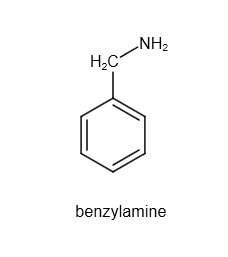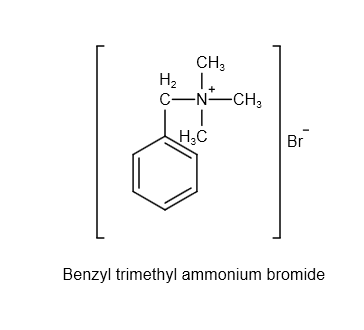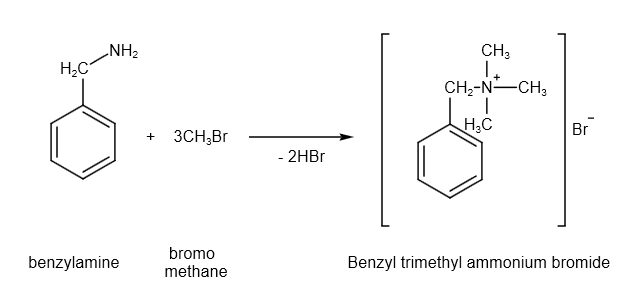
A reaction of \[0.1\] mole of benzyl amine with bromomethane gave \[23g\] of benzyl trimethyl ammonium bromide. The number of moles of bromomethane consumed in this reaction are \[n \times {10^{ - 1}}\] , when \[n = \] _______. (Round off to the Nearest Integer). [Given: Atomic masses: C: \[12.0{\text{ }}u\] , H: \[1.0{\text{ }}u\], N: \[14.0{\text{ }}u\], Br: \[80.0{\text{ }}u\] ]
Answer
224.7k+ views
Hint: The structure of benzyl amine is as follows:

Image: Structure of benzylamine
The structure of benzyl trimethyl ammonium bromide is as follows:

Image: structure of benzyl trimethyl ammonium bromide
Complete Step by Step Solution:
There is a reaction between benzylamine and bromoethane produces benzyl trimethyl ammonium bromide. The balanced chemical reaction is as follows:

Image: reaction between benzylamine and bromomethane
From the reaction stoichiometry, one mole of benzylamine reacts with three moles of bromomethane and produces one mole of benzyl trimethyl ammonium bromide.
Here, \[0.1\] mole of benzyl amine reacts with bromomethane and gave \[23g\] of benzyl trimethyl ammonium bromide.
First of all, we have to calculate the molar mass of benzyl trimethyl ammonium bromide.
From the structure, the chemical formula of benzyl trimethyl ammonium bromide is \[{C_{10}}{H_{16}}NBr\] .
Calculate the molar mass of \[{C_{10}}{H_{16}}NBr\] from the given atomic masses as follows:
\[
{\text{molar mass of }}{C_{10}}{H_{16}}NBr = 10\left( {12.0} \right) + 16\left( {1.0} \right) + 14.0 + 80.0 \\
\Rightarrow {\text{molar mass of }}{C_{10}}{H_{16}}NBr = 230 \\
\]
Therefore, the molar mass of \[{C_{10}}{H_{16}}NBr\] is \[230\].
We have to calculate the moles of \[{C_{10}}{H_{16}}NBr\] from given mass ( \[23g\] ).
We know that,
\[n = \dfrac{{weight}}{{mol.mass}}\]
Substituting the values,
\[
{n_{{C_{10}}{H_{16}}NBr}} = \dfrac{{23}}{{230}} \\
\Rightarrow {n_{{C_{10}}{H_{16}}NBr}} = 0.1 \\
\]
From the reaction stoichiometry,
\[1\] mole of \[{C_{10}}{H_{16}}NBr\] formed from \[3\] moles of bromomethane.
Calculate the number of moles of bromomethane requires for \[0.1\] mole of \[{C_{10}}{H_{16}}NBr\] formation as follows:
\[
{n_{C{H_3}Br}} = 0.1{\text{ }} \times \dfrac{3}{1} \\
\Rightarrow {n_{C{H_3}Br}} = 0.3 \\
\]
The number of moles consumed in the reaction are \[n \times {10^{ - 1}}\] .
So, we can say that,
\[
n \times {10^{ - 1}} = {n_{C{H_3}Br}} \\
\Rightarrow n \times {10^{ - 1}} = 0.3 \\
\Rightarrow n = 3 \\
\]
Therefore, the value of \[n\] is \[3\] .
Note: Mole, or mol, is a common scientific unit in chemistry that is used to measure vast amounts of tiny objects such as molecules, atoms, or other particles. The number of moles of a solute in a litre of solution is known as molarity. A mole is a unit of measurement that helps us match the particles of a substance to its mass. The molecular weight, also known as molar mass, is the sum of the masses of each atom in grammes that make up a mole of a molecule.

Image: Structure of benzylamine
The structure of benzyl trimethyl ammonium bromide is as follows:

Image: structure of benzyl trimethyl ammonium bromide
Complete Step by Step Solution:
There is a reaction between benzylamine and bromoethane produces benzyl trimethyl ammonium bromide. The balanced chemical reaction is as follows:

Image: reaction between benzylamine and bromomethane
From the reaction stoichiometry, one mole of benzylamine reacts with three moles of bromomethane and produces one mole of benzyl trimethyl ammonium bromide.
Here, \[0.1\] mole of benzyl amine reacts with bromomethane and gave \[23g\] of benzyl trimethyl ammonium bromide.
First of all, we have to calculate the molar mass of benzyl trimethyl ammonium bromide.
From the structure, the chemical formula of benzyl trimethyl ammonium bromide is \[{C_{10}}{H_{16}}NBr\] .
Calculate the molar mass of \[{C_{10}}{H_{16}}NBr\] from the given atomic masses as follows:
\[
{\text{molar mass of }}{C_{10}}{H_{16}}NBr = 10\left( {12.0} \right) + 16\left( {1.0} \right) + 14.0 + 80.0 \\
\Rightarrow {\text{molar mass of }}{C_{10}}{H_{16}}NBr = 230 \\
\]
Therefore, the molar mass of \[{C_{10}}{H_{16}}NBr\] is \[230\].
We have to calculate the moles of \[{C_{10}}{H_{16}}NBr\] from given mass ( \[23g\] ).
We know that,
\[n = \dfrac{{weight}}{{mol.mass}}\]
Substituting the values,
\[
{n_{{C_{10}}{H_{16}}NBr}} = \dfrac{{23}}{{230}} \\
\Rightarrow {n_{{C_{10}}{H_{16}}NBr}} = 0.1 \\
\]
From the reaction stoichiometry,
\[1\] mole of \[{C_{10}}{H_{16}}NBr\] formed from \[3\] moles of bromomethane.
Calculate the number of moles of bromomethane requires for \[0.1\] mole of \[{C_{10}}{H_{16}}NBr\] formation as follows:
\[
{n_{C{H_3}Br}} = 0.1{\text{ }} \times \dfrac{3}{1} \\
\Rightarrow {n_{C{H_3}Br}} = 0.3 \\
\]
The number of moles consumed in the reaction are \[n \times {10^{ - 1}}\] .
So, we can say that,
\[
n \times {10^{ - 1}} = {n_{C{H_3}Br}} \\
\Rightarrow n \times {10^{ - 1}} = 0.3 \\
\Rightarrow n = 3 \\
\]
Therefore, the value of \[n\] is \[3\] .
Note: Mole, or mol, is a common scientific unit in chemistry that is used to measure vast amounts of tiny objects such as molecules, atoms, or other particles. The number of moles of a solute in a litre of solution is known as molarity. A mole is a unit of measurement that helps us match the particles of a substance to its mass. The molecular weight, also known as molar mass, is the sum of the masses of each atom in grammes that make up a mole of a molecule.
Recently Updated Pages
JEE Main 2026 Session 1 Correction Window Started: Check Dates, Edit Link & Fees

JEE Isolation, Preparation and Properties of Non-metals Important Concepts and Tips for Exam Preparation

Isoelectronic Definition in Chemistry: Meaning, Examples & Trends

Ionisation Energy and Ionisation Potential Explained

Iodoform Reactions - Important Concepts and Tips for JEE

Introduction to Dimensions: Understanding the Basics

Trending doubts
JEE Main 2026: City Intimation Slip and Exam Dates Released, Application Form Closed, Syllabus & Eligibility

JEE Main 2026 Application Login: Direct Link, Registration, Form Fill, and Steps

Understanding the Angle of Deviation in a Prism

How to Convert a Galvanometer into an Ammeter or Voltmeter

Hybridisation in Chemistry – Concept, Types & Applications

Ideal and Non-Ideal Solutions Explained for Class 12 Chemistry

Other Pages
JEE Advanced Marks vs Ranks 2025: Understanding Category-wise Qualifying Marks and Previous Year Cut-offs

Thermodynamics Class 11 Chemistry Chapter 5 CBSE Notes - 2025-26

Organic Chemistry Some Basic Principles And Techniques Class 11 Chemistry Chapter 8 CBSE Notes - 2025-26

JEE Advanced 2026 - Exam Date (Released), Syllabus, Registration, Eligibility, Preparation, and More

JEE Advanced 2026 - Exam Date (Released), Syllabus, Registration, Eligibility, Preparation, and More

Hydrocarbons Class 11 Chemistry Chapter 9 CBSE Notes - 2025-26




